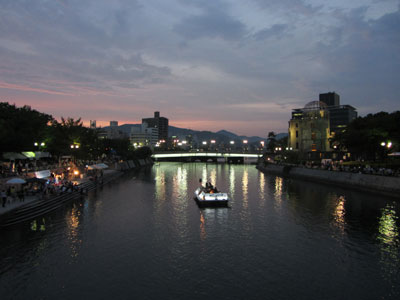Hiroshima Travelogue - Episode 11
We move out of the Chugoku daily; exactly called the Chugoku Shimbun daily. They say it circulates some 700,000 copies every day. It will publish an article about the meeting between members of [Iran’s] Peace Museum (us) and survivors of the atomic bombings of Hiroshima.
Here we go to the Peace Park. Everything seems to be ready to the upcoming ceremony. Erected in a corner of the park is a monument to the Hiroshima Bombing with a map of the building at its entrance and a structure at the end with a Japanese epigraph and a large clock showing 8:15; the exact time of the bombing on August 6th 1945. The clock is wet; water pours over the clock and forms a little pond about it as a memorial to those who perished out of thirst and injury. The debris garnered from the ruins of the bombing is placed about the pond.

The river beside the Peace Park; the picture shows the remnants of a dome structure which have survived the Hiroshima bombings.
We step in a steep path to reach the main building of the complex. The bomb hit the ground some 200 meters away north east of the complex. The building’s entrance is decorated with innumerable pictures of probably the event’s victims. We keep on our way down the steep path anti-clockwise to get to the main hall; to the day of the bombardment.

Entrance of the Monument
Here is a round structure with a 360 degree view. It is constructed with over 140,000 pieces to resemble those killed directly or indirectly in the bombing until the end of 1945. 12 pillars keep the structure up and are said to be the link between present and the past; or the alive and the dead. Right in the middle of the round structure is the time 8:15 inscribed on a stone watch covered with water current. The monument abounds with meaning despite simplicity.
We also pop in other spots of the Hiroshima memorial complex during our visit. Numerous screens are placed in a hall to give visitors information of any kind about the A-bomb attack in the city. Visitors are also allowed to access archives of memoirs belonging to the survivors and their pictures of the incident. All the data is available in Japanese, English, Chinese and Korean.
***

The sunset in Hiroshima
Accompanied with some of our group members who still could and would continue the visit, we went to the riverside as the sun was about to set. Music could be heard from the river bank. The players played it flawlessly. It is like it’s being played in memory of the August 6 victim. Here are individuals from the green and black continents not to mention the attending Japanese. A backpacking lad happens to realize that we are from Iran and comes closer. He says he is from Canada and calls US President Obama’s name several times. I don’t know what he is thinking but he smells of booze as I take a picture with him.
Hedayatollah Behboudi
Translated by: Abbas Hajihashemi
Number of Visits: 5435








The latest
- Third Regiment: Memoirs of an Iraqi Prisoner of War Doctor – 11
- 100 Questions/10
- The 23rd Commemoration Ceremony of the Martyrs of the Ansar al-Rasul Battalion Held
- A Narrative of Pakistani Pedestrian Pilgrims of Arbaeen in Sistan and Baluchestan
- Oral History Methodology/National Archives and Library Organization of Iran, Archives Research Institute
- Third Regiment: Memoirs of an Iraqi Prisoner of War Doctor – 10
- 100 Questions/9
- Oral History News – Aban 1404
Most visited
- Third Regiment: Memoirs of an Iraqi Prisoner of War Doctor – 9
- The Relationship between “Religious Jurisprudence” and “Oral History”
- Oral History News – Aban 1404
- 100 Questions/9
- Oral History Methodology/National Archives and Library Organization of Iran, Archives Research Institute
- Third Regiment: Memoirs of an Iraqi Prisoner of War Doctor – 10
- A Narrative of Pakistani Pedestrian Pilgrims of Arbaeen in Sistan and Baluchestan
- The 23rd Commemoration Ceremony of the Martyrs of the Ansar al-Rasul Battalion Held
100 Questions/6
We asked several researchers and activists in the field of oral history to express their views on oral history questions. The names of each participant are listed at the beginning of their answers, and the text of all answers will be published on this portal by the end of the week. The goal of this project is to open new doors to an issue and promote scientific discussions in the field of oral history.The Importance of Pre-Publication Critique of Oral History Works
According to the Oral History website, a meeting for critique and review of the book “Oral History: Essence and Method” was held on Monday morning, November 10, 2025, with the attendance of the book’s author, Hamid Qazvini, and the critics Mohammad Qasemipour and Yahya Niazi, at the Ghasr-e Shirin Hall of the National Museum of the Islamic Revolution and Sacred Defense.Challenges of Interviewing in Oral History
After years of studying the theoretical foundations of oral history, conducting numerous interviews and going through their post-interview stages, as well as reading the available body of oral history literature, I was eventually given the opportunity to evaluate the edited versions of dozens of oral history projects.Comparing the Narratives of Commanders and Ordinary Combatants in the Sacred Defense
An Analysis of Functions and ConsequencesThe experience of the Sacred Defense cannot be comprehended merely through statistics or official reports; what truly endures from war are the narratives of those who stood upon its frontlines. These narratives, however, vary significantly depending on one’s position, responsibilities, and lived experience.


